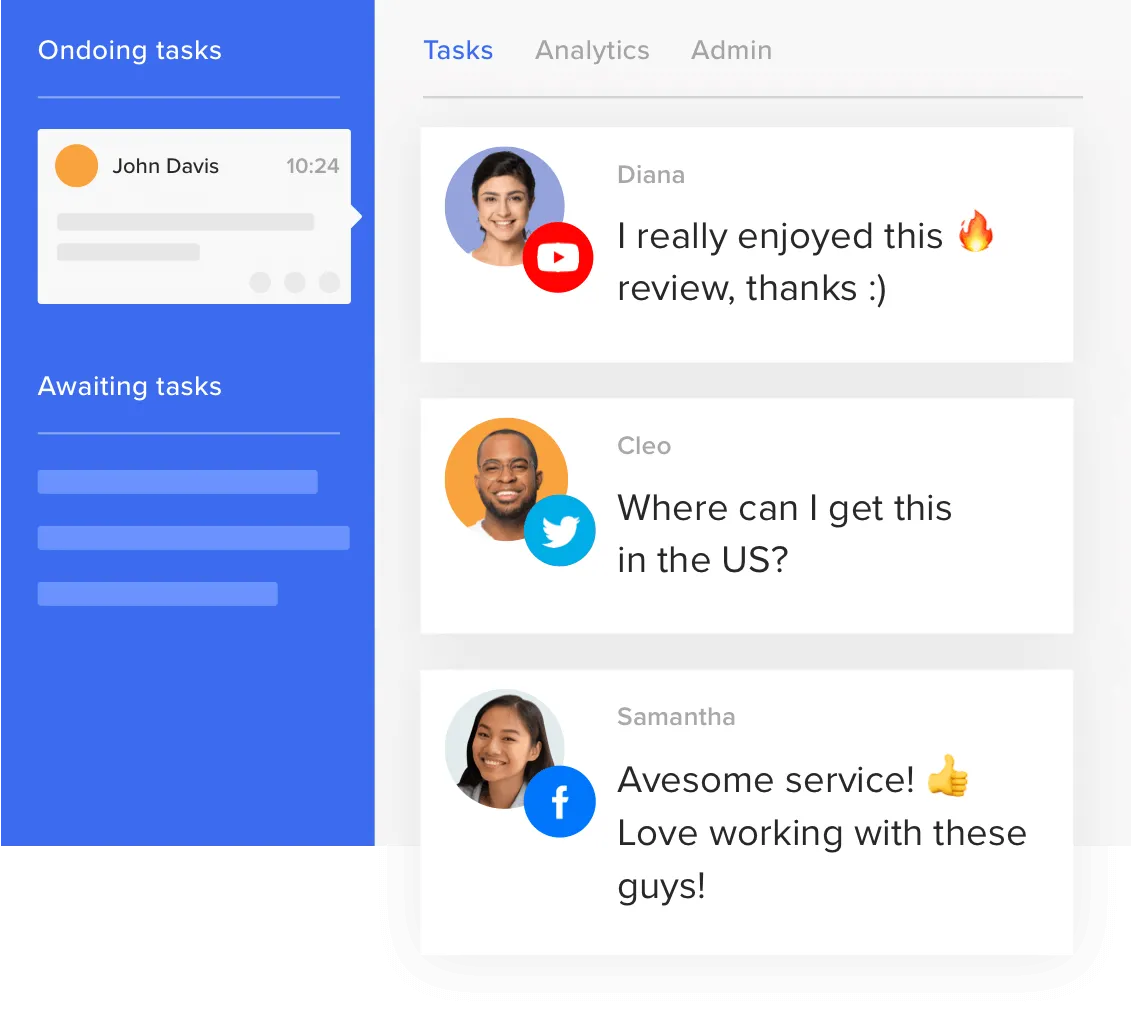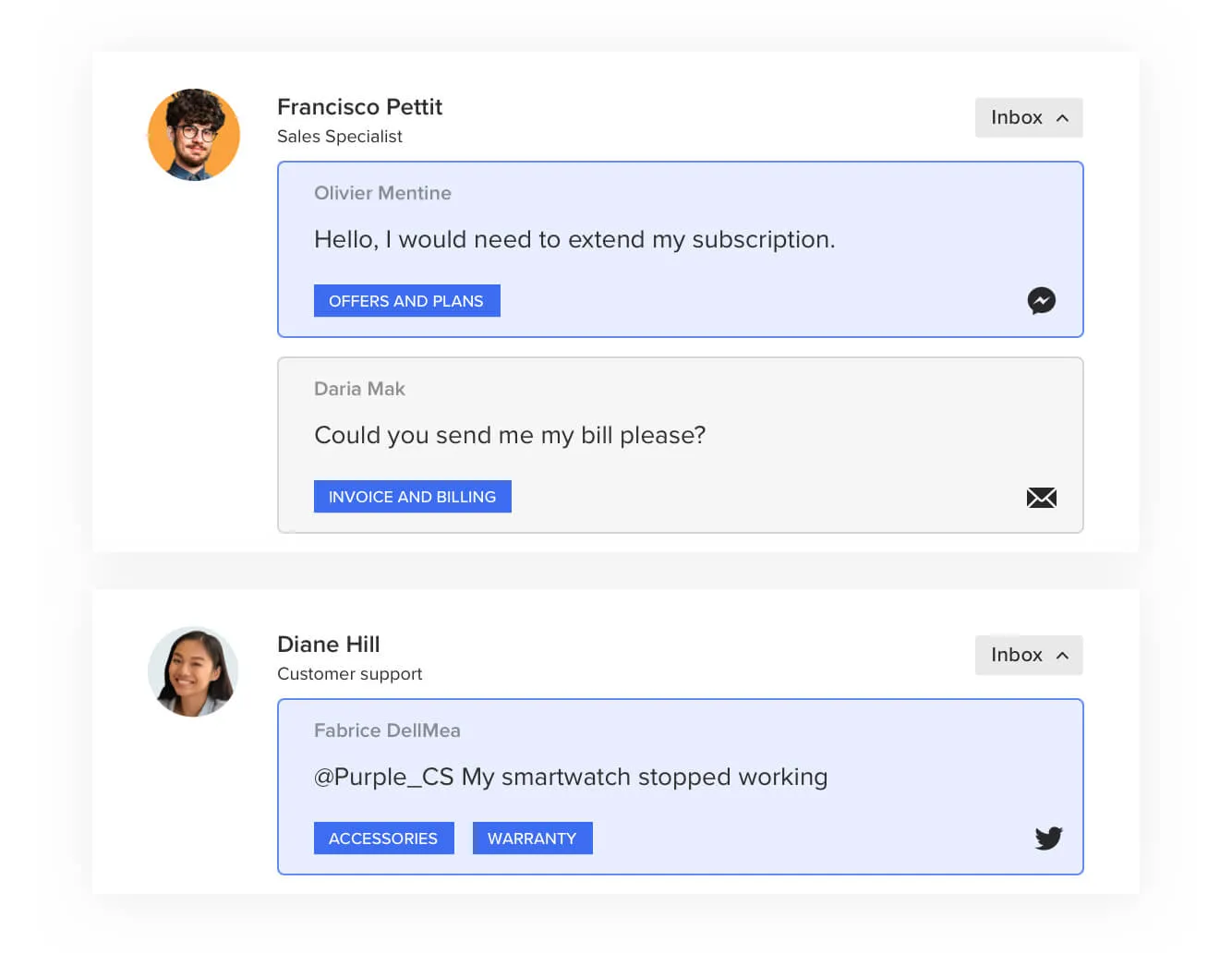Digital customer service channels for enhanced customer experience


Creating positive customer experiences is a vital part of running a successful business. It’s no longer enough to have top-tier staff in your physical store or call center - consumers expect the same treatment over digital customer service channels too.
What is digital customer service?
There are a lot of online interactions between customers and companies that aren’t ‘digital customer service’ - for instance, a customer sharing something to their Instagram story would be engagement, but not customer service.
There’s also ‘sales support’, where a customer interacts with your company before and during a sale, for instance, asking product details through web chat. This is distinct from customer service, which is usually a post-sales interaction.
Digital customer service is specifically any online interaction that helps meet customer needs. Responding to a complaint email, processing a refund through live chat, and answering a product question on Twitter are all examples of digital customer service.
What are digital interactions?
Active digital interactions could be engaging with a chatbot, responding to a social media post, or receiving customer support through email. However, you can also have passive interactions - a customer looking through your website self-service knowledge base or watching a tutorial video.
These interactions are a key part of digital customer engagement, and improving them is the best way to improve your customer satisfaction. Ideally, you want to have an omnichannel strategy in place to allow for interactions over multiple channels.
What is omnichannel customer service?
As mentioned, omnichannel customer service covers interactions over multiple channels. However, it is distinct from multi-channel customer service in one key way: the channels are treated as parts of a greater whole.

Instead of treating each channel as an independent entity, insights and data are gathered and shared. It creates a cohesive digital experience for both consumers and staff. For consumers, they can feel confident that when they approach you on any digital platform like email, chat or social media.
For agents, it makes their job much simpler, as they don’t have to swap between customer channels and track information and interactions on each one separately. Instead, they can seamlessly interact with them through a single platform that encompasses a variety of digital channels.
Why do you need a digital customer service strategy?
You might wonder why you need a specific digital customer service strategy. You may already have a general customer strategy, but there are many aspects of digital engagement that are different from in-person interaction. As such, they need specific, targeted strategies. There are two main areas to consider.
Customer Engagement
Engaging with your customers digitally is very different from engaging them in a physical location or through a call center. Interactions on social media or through live chat lack face-to-face connection so many tried and tested sales strategies may falter. Interacting with customers through voice calls through your call center at least allows you to rely on tone, while solely text-based conversation does not. However, it’s easier than ever to encourage customers to engage with you in real-time.
Having a great virtual strategy in place lets you find customers where they are and encourage them to come to you. They might be on your website, lingering on a product - and your chatbot can pop up and offer advice. Perhaps they’re in your mobile app, but struggling to make a purchase, so your webchat reaches out to help.
New forms of engagement are possible - posting user-generated content to Instagram or gathering responses to a hashtag on Twitter. Understanding how to use these tactics to your advantage on digital customer service channels is vital to building a trusted, well thought of brand.
Customer Satisfaction
From (positive) customer engagement comes customer satisfaction. By focusing on a specific digital channel strategy, you can ensure your customers are satisfied with your service. It enables you to meet their expectations and go beyond them. Remember: consumers want businesses that understand their needs, and you can’t do that without an effective digital customer experience strategy in place.
How do you promote digital services to customers?
Of course, all these improvements to customer care are useless if no one knows about your services. Here are a few ways to promote digital services to your customers.
Live chat
Whether it’s messaging a human agent, a chatbot, or an AI-powered virtual agent, live chat is a must-have. Rather than hiding it away on your ‘contact us’ page, have it as a pop-up in the corner of your site. It will catch customers’ attention and encourage them to make use of it. You also need to be available on other platforms, like Facebook Messenger.

Social media
Any social media pages you have should be easy to find. That means having similar (preferably identical) names on every platform and posting links on your website. One great way to promote these channels is to run an email marketing campaign that highlights them - potentially with platform-specific contests or offers to encourage engagement.
Text message
Many people would appreciate an SMS reminder about a delivery but don’t realize businesses offer the service. A great way to highlight this digital service is to mention it during the checkout process. Rather than having a small tick box near the terms and conditions, make it stand out and have a link with more information about text messaging available.
This should be the easiest to promote, but you’d be surprised how many businesses don’t openly provide addresses! Contact forms are well and good, but many customers want to email directly through their accounts to keep better records.
Dedicate space on your ‘contact us’ or ‘customer support’ page to the ways they can contact you through email. Ideally, different departments should have separate email addresses - you don’t want everything piling into the same inbox. This way, you can provide fast responses and exceed customer expectations.
Website
Depending on how your customers engage with you, you may need to promote your website. If they’re more familiar with your social media profiles, they might not engage with you there. Encourage them to click through by showing off teasers rather than complete content.
If you have an interactive voice response (IVR) or automatic call distributor (ACD) on your phone system, you should also set up an automated message explaining what you can do through the website. Many people will call in with issues that can be resolved online, so by promoting your website through your contact center; you’ll drive engagement and optimize your workflow.
Tips on how to improve digital customer experience management
Now you understand what digital customer service channels are available, how to promote them, and why they’re useful, it’s time to consider how to improve your usage of them.
Deflect customer interactions to digital channels
If your phone lines are busy, why not offer people a link to start an interaction on a digital channel? This could be done through an automated message on your phone line, or by offering to send an SMS with a link.
Apply digital transformation techniques to as many interactions as possible, rather than defaulting to more traditional methods. Loyalty schemes with physical cards can be linked to online accounts, physical catalogs can be replaced with virtual ones; and face-to-face meetings with video chat. Embrace digitalization fully, and you’ll reap the benefits.
Choose the right customer service channel
Of course, it’s not enough to move into the digital world - you need to move to the right support channel. If you’re a beauty brand, you’re not going to find your customers on a platform dedicated to businesses. Equally, a recruitment company is probably going to struggle on the latest social app.

Spend time analyzing your customers’ preferred channel, and meet them there. That’s not to say you shouldn’t explore platforms beyond this, but that you need to understand your target market.
Have distinct strategies for distinct digital channels
You wouldn’t treat an in-store interaction like an email, and this should apply for digital channels too. While you might be managing them through a single platform, each digital channel will have its own trends, tactics and best practices. For instance, Twitter has a character limit, so you’d need to craft short, to-the-point messages.
Ideally, your omnichannel solution needs to be smart enough to know these rules, and help your agents meet them.
Managing an omnichannel digital strategy
While you could try to handle each platform separately, we wouldn’t advise it. Instead, omnichannel customer service platform gives your team an easy way to monitor a variety of digital customer service channels. It allows you to implement strategies quickly and effectively, as well as providing detailed data to build improvements from.

Your call center should become a contact center - covering all aspects of communication, not just phone calls.